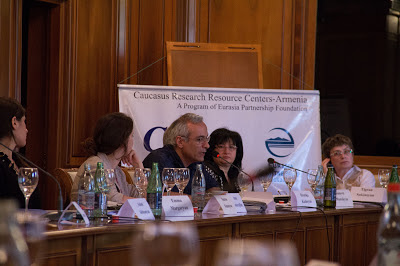Conference on Social Capital: Definitions, Applications, Cultural Contexts
Conference on Social Capital: Definitions, Applications, Cultural Contexts
Date:
June 17, 2013

By CRRC-Armenia Junior Fellow Anahit Hakobyan
On June 6, 2013 CRRC-Armenia hosted a conference on social capital aimed at deepening the knowledge and scholarship on the subject in Armenia. The conference brought together academics, researchers, NGO representatives, government officials, and scholars of different disciplines to focus on the implications and applications of social capital in Armenia and the South Caucasus.
The conference was comprised of three separate sessions focusing on the theoretical, empirical, and cultural aspects of social capital. The theoretical panel was chaired by Dr. Sabine Freizer, Senior Fellow at the Atlantic Council, and focused mainly on the issues surrounding the definition of social capital, as well as the different types of social capital; namely, bonding and bridging. Dr. Freizer concluded the session by linking the idea of bridging social capital with current events in Turkey.
The empirical panel concentrated on the methodological approaches for the measurement of social capital as well as differentiating between the positive aspects of social capital and the idea of “negative social capital”. This session was chaired by Dr. Koba Turmanidze, the Executive Director of CRRC-Georgia,who put forth a methodological approach to measure social capital in South Caucasusby creating a social capital index using CRRC’s Caucasus Barometer. Dr. Turmanidze’s work found that the social capital index was highest in Georgia (5.7 out of 6), while the scores in Armenia and Azerbaijan were 4.6 and 4.8, respectively.The session also stressed the importance of solving problems that can arise from misunderstanding and misusing the concept.
The cultural panel was chaired by Dr. Heghine Manasyan, Executive Director of CRRC-Armenia, and investigated the cultural implications of social capital, particularly in contemporary Armenian society.
Lastly, building off the work done by Dr. Turmanidze, CRRC-Armenia Junior Fellows Ani Karapetyan and Tigran Sukiasyan made a presentation linking interest in migration and online networks to social capital in Armenia. It was very engaging presentation,which discovered that frequent internet users have a high average social capital index rating and that in the capital and rural areas the trust index is higher for those not interested in migration than those who are.
During each session scholars and students of different backgrounds delivered presentations on their research, which were followed by productive and thought provoking discussions. The papers are currently being revised and edited based on the comments provided at the conference and will be published this summer.
Category
Blog



